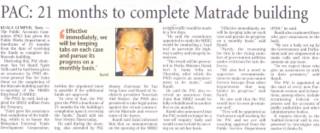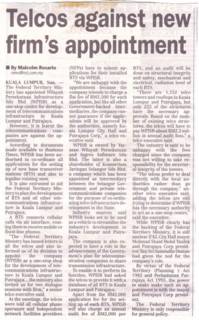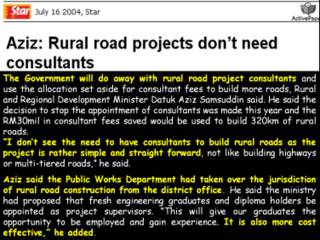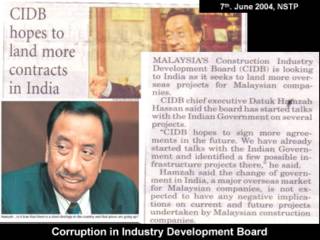PMC puncanya, bukan JKR
"Dari tahun 1979 saya jadi menteri tidak pernah jadi macam ini"
- KATA DATUK SERI SAMY VELLU.
Utusan Online, 14th November 2004.
Datuk Seri Samy Vellu finally had finally the guts to come out in the open to bare all the viruses and worms that had plague the projects and had infected and infiltrated the whole Kitchen Cabinet.
Who was responsible for all the fiascos of project failures?
According to Samy Vellu, it is none other than the KSU, the Secretary general of the Finance Ministry who is the most powerful person in regards to decisions on project award.
This is what Samy says:
Tetapi orang yang bertanggungjawab itu ialah Ketua Setiausaha kementeriannya. Ketua Setiausaha saja yang memberi arahan dan dia selalu tidak boleh menerima pandangan lain. Dalam satu-satu mesyuarat kalau ada para pegawai dari JKR untuk menjaga kepentingan teknikal, dia selalu malukan mereka. Dia kata, kalau tidak tahu tutup mulut."
"Beliau sedar bahawa semua masalah itu hanya muncul setelah perkhidmatan Perunding Pengurusan Projek (PMC) diperkenalkan oleh Kementerian Kewangan pada tahun 1990-an."
WHO DECIDES TO SET UP THE PMC?
This is what Samy says:
"Ia ditubuhkan oleh Kementerian Kewangan pada tahun 1990-an. Peranannya ialah untuk memansuhkan projek-projek JKR. Ada kepercayaan bahawa sekiranya projek-projek itu diberikan kepada PMC ia boleh disiapkan dengan lebih awal, lebih cantik dan macam-macam lagi. Malah projek yang mereka siapkan itu sebenarnya lebih mahal."
According to Samy, In the early 1990s, Mahathir's Govt had decided to engage the service of a Project Management Consultant (PMC) which are a composite cartel with faces and looks that resemble a contractor, may look like consultant and had shown interest as property developers and that entity is registered with the Ministry of Finance. The set up of PMC was meant to hijack all JKR's mega projects. It was claimed by the PMC that they are more efficient, more cost effective and can do a better job than JKR. The results speaks of itself: - Computer lab projects, Matrade Building, Hospital Sultan Ismail di Pandan, Johor, Kangar Hospital, Cameron Hospital, Langkawi School projects, et al; all these projects are now reverted back to JKR for reorganization and restructuring - to mitigate the damages done, and the multi million loses incurred; all tax-payers money.
As revealed by Samy, the PMC is a private entity who had only 2 officers manning the company - a managing director and a deputy managing director, and NO others. The Government, via the Ministry of Finance had entrusted and delegated the power to this PMC to appoint and select any contractors, design engineers, consultants, and nominated sub-contractors for all projects parked within their jurisdiction or those within the jurisdiction of the Ministry of Finance.
Snip from the interview:
Q: "Sebenarnya apabila Kementerian Kewangan sudah memberikan sesuatu projek itu kepada sesebuah kontraktor, tanggungjawab saya sebagai menteri hanyalah mengarahkan JKR supaya melantik kontraktor itu. Saya memberikan kuasa kepada Ketua Pengarah JKR untuk melantik kontraktor itu untuk harga yang telah ditentukan. Itu saja.
"Dari tahun 1979 saya jadi menteri tidak pernah jadi macam ini"
- KATA DATUK SERI SAMY VELLU.
Utusan Online, 14th November 2004.
Datuk Seri Samy Vellu finally had finally the guts to come out in the open to bare all the viruses and worms that had plague the projects and had infected and infiltrated the whole Kitchen Cabinet.
Who was responsible for all the fiascos of project failures?
According to Samy Vellu, it is none other than the KSU, the Secretary general of the Finance Ministry who is the most powerful person in regards to decisions on project award.
This is what Samy says:
Tetapi orang yang bertanggungjawab itu ialah Ketua Setiausaha kementeriannya. Ketua Setiausaha saja yang memberi arahan dan dia selalu tidak boleh menerima pandangan lain. Dalam satu-satu mesyuarat kalau ada para pegawai dari JKR untuk menjaga kepentingan teknikal, dia selalu malukan mereka. Dia kata, kalau tidak tahu tutup mulut."
"Beliau sedar bahawa semua masalah itu hanya muncul setelah perkhidmatan Perunding Pengurusan Projek (PMC) diperkenalkan oleh Kementerian Kewangan pada tahun 1990-an."
WHO DECIDES TO SET UP THE PMC?
This is what Samy says:
"Ia ditubuhkan oleh Kementerian Kewangan pada tahun 1990-an. Peranannya ialah untuk memansuhkan projek-projek JKR. Ada kepercayaan bahawa sekiranya projek-projek itu diberikan kepada PMC ia boleh disiapkan dengan lebih awal, lebih cantik dan macam-macam lagi. Malah projek yang mereka siapkan itu sebenarnya lebih mahal."
According to Samy, In the early 1990s, Mahathir's Govt had decided to engage the service of a Project Management Consultant (PMC) which are a composite cartel with faces and looks that resemble a contractor, may look like consultant and had shown interest as property developers and that entity is registered with the Ministry of Finance. The set up of PMC was meant to hijack all JKR's mega projects. It was claimed by the PMC that they are more efficient, more cost effective and can do a better job than JKR. The results speaks of itself: - Computer lab projects, Matrade Building, Hospital Sultan Ismail di Pandan, Johor, Kangar Hospital, Cameron Hospital, Langkawi School projects, et al; all these projects are now reverted back to JKR for reorganization and restructuring - to mitigate the damages done, and the multi million loses incurred; all tax-payers money.
As revealed by Samy, the PMC is a private entity who had only 2 officers manning the company - a managing director and a deputy managing director, and NO others. The Government, via the Ministry of Finance had entrusted and delegated the power to this PMC to appoint and select any contractors, design engineers, consultants, and nominated sub-contractors for all projects parked within their jurisdiction or those within the jurisdiction of the Ministry of Finance.
Snip from the interview:
Q: "Sebenarnya apabila Kementerian Kewangan sudah memberikan sesuatu projek itu kepada sesebuah kontraktor, tanggungjawab saya sebagai menteri hanyalah mengarahkan JKR supaya melantik kontraktor itu. Saya memberikan kuasa kepada Ketua Pengarah JKR untuk melantik kontraktor itu untuk harga yang telah ditentukan. Itu saja.
Ini bermakna Kementerian Kewangan mempunyai kuasa yang lebih besar walaupun Kementerian Kerja Raya mempunyai pakar yang boleh memberikan nasihat?"
SAMY REPLIED: YA, BETUL.
Q: Siapakah yang memeriksa PMC?
SAMY: TIADA SIAPA. (believe it? NObody manages or control or audit the PMC!!!)
Q: Kerajaan ada JKR tetapi kenapakah kerajaan memilih untuk memberi kepercayaan kepada badan swasta mengendalikan projek yang bernilai berjuta-juta ringgit? Apakah rasionalnya?
SAMY: Ada satu jawapan saja kepada soalan ini. Kata mereka, kerja-kerja itu boleh disiapkan dalam jangka masa yang cepat.
Q: Tanpa mempedulikan soal kos?
SAMY: Ya, tanpa mempedulikan kos. Apabila JKR membuka tawaran bagi setiap bilik darjah dengan harga RM55,000, ada juga pemaju yang bersedia menyiapkannya. Tetapi sebuah bilik darjah yang ditawarkan melalui PMC ada yang berharga RM95,000 dan ada juga yang mencecah sehingga RM120,000.
Kosnya sekarang sudah jadi berganda. Apabila kita tanya kenapa harganya jadi begitu tinggi mereka nanti akan beri berbagai-bagai penjelasan.
Sekolah-sekolah yang dibina dengan harga yang tinggi itu memang cantik-cantik. Tetapi siapa yang hilang wang? Kerajaan.
Q: Adakah pemaju-pemaju itu dapat menyiapkan projek-projek berkenaan dengan cepat seperti yang dijanjikan?
SAMY: Tidak juga. Ada sekali itu JKR telah diminta supaya mengeluarkan satu tawaran untuk pembinaan 500 buah sekolah dan kita sudah memilih lebih daripada 200 pemaju untuk melaksanakannya.
Tetapi apabila sampai masa kita hendak mengeluarkan surat niat, JKR telah diminta supaya menarik balik semua tawaran itu dan menyerahkannya kepada PMC. Semudah itu saja.
Q: Apa yang istimewanya tentang PMC ini?
SAMY: PMC LEBIH KUAT DARIPADA KITA.
Believe what you hear from Samy? PMC is stronger than Ministry of Works?
Is this the Government we had? That even the MINISTRY can be overruled by a PMC?
How is it that this can happen?
How is it that the Government had developed a dinosaur from a lizard within such a short span of a few years that is capable to destroy the Works Ministry and billions of dollars of project?
Who is behind the PMC?
Who's the GODFATHER behind it?
It cannot be the Jews?
Only UNMO can answer it; TRUST me!









